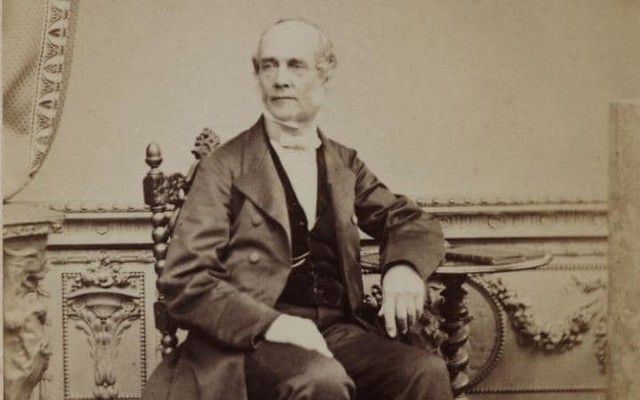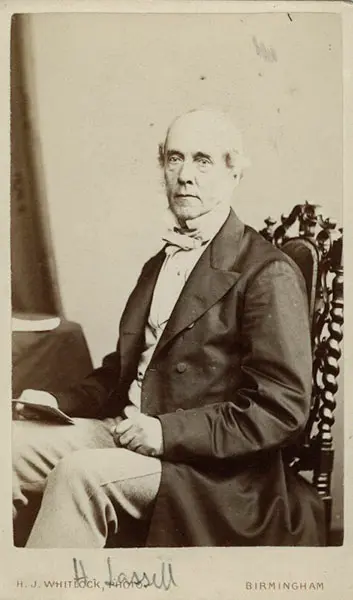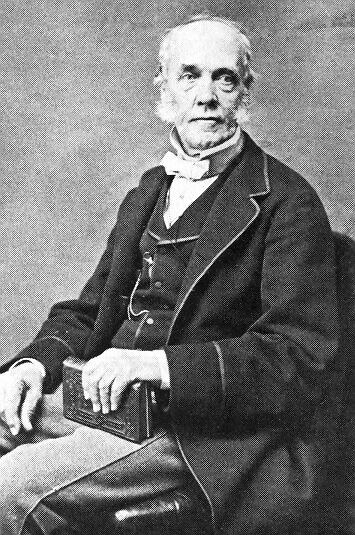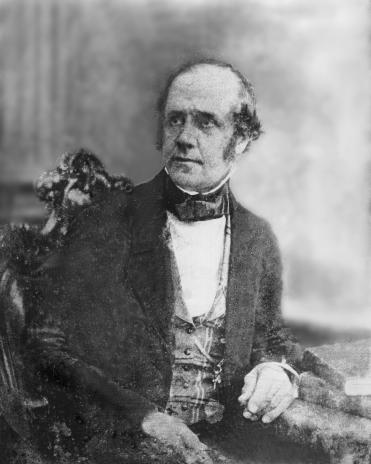
Today is the birthday of William Lassell (June 18, 1799–October 5, 1880). He made great contributions to astronomy throughout his life, but that “hobby” was funded by the fortune he made at his Liverpool brewery. He was initially trained as a merchant, and in 1825 started an apparently successful brewery, and one account states that he “married a widow of a wealthy Liverpool brewer gaining at the same time financial independence.” That may have given him the idea. Perhaps because his life was overshadowed by his astronomical pursuits, there’s very little about his brewery I could find, although I believe it was known as Lassell & Sharman Ltd.

Here’s his basic biography from his Wikipedia page:

William Lassell was born in Bolton, Lancashire, a town west of Manchester. He was educated first in Bolton then at Rochdale Academy. After the death of his father, he was apprenticed from 1814 to 1821 to a merchant in Liverpool. He then made his fortune as a beer brewer, which enabled him to indulge his interest in astronomy. He built an observatory at his house “Starfield” in West Derby, a suburb of Liverpool. There he had a 24-inch (610 mm) reflector telescope, for which he pioneered the use of an equatorial mount for easy tracking of objects as the Earth rotates. He ground and polished the mirror himself, using equipment he constructed. The observatory was later (1854) moved further out of Liverpool, to Bradstone.
In 1846 Lassell discovered Triton, the largest moon of Neptune, just 17 days after the discovery of Neptune itself by German astronomer Johann Gottfried Galle. In 1848 he independently co-discovered Hyperion, a moon of Saturn. In 1851 he discovered Ariel and Umbriel, two moons of Uranus.
When Queen Victoria visited Liverpool in 1851, Lassell was the only local she specifically requested to meet.
In 1855, he built a 48-inch (1,200 mm) telescope, which he installed in Malta because of the observing conditions that were better than in often-overcast England. On his return to the UK after several years in Malta he moved to Maidenhead and operated his 24-inch (610 mm) telescope in an observatory there. The 48-inch telescope was dismantled and was eventually scrapped.
Lassell was a Fellow of the Royal Astronomical Society (FRAS) from 1839, won the Gold Medal of the Royal Astronomical Society in 1849, and served as its president for two years starting in 1870. He was elected a Fellow of the Royal Society (FRS) in 1849 and won their Royal Medal in 1858. Lassel was also a Fellow of the Royal Society of Literature (FRSL). He was furthermore elected an honorary Fellow of the Royal Society of Edinburgh (HonFRSE) and of the Society of Sciences of Upsala, and received an honorary LL.D. degree from the University of Cambridge in 1874.
Lassell died in Maidenhead in 1880. Upon his death, he left a fortune of £80,000 (roughly equivalent to £7,200,000 in 2015). His telescope was presented to the Royal Observatory in Greenwich.
The crater Lassell on the Moon, a crater on Mars, the asteroid 2636 Lassell and a ring of Neptune are named in his honour.

This account of Lassell is from A Popular History of Astronomy During the Nineteen Century, by Agnes M. Clerke, published in 1885:
Within seventeen days of its identification with the Berlin achromatic, Neptune was found to be attended by a satellite. This discovery was the first notable performance of the celebrated two-foot reflector[224] erected by Mr. Lassell at his suggestively named residence of Starfield, near Liverpool. William Lassell was a brewer by profession, but by inclination an astronomer. Born at Bolton in Lancashire, June 18, 1799, he closed a life of eminent usefulness to science, October 5, 1818, thus spanning with his well-spent years four-fifths of the momentous period which we have undertaken to traverse. At the age of twenty-one, being without the means to purchase, he undertook to construct telescopes, and naturally turned his attention to the reflecting sort, as favouring amateur efforts by the comparative simplicity of its structure. His native ingenuity was remarkable, and was developed by the hourly exigencies of his successive enterprises. Their uniform success encouraged him to enlarge his aims, and in 1844 he visited Birr Castle for the purpose of inspecting the machine used in polishing the giant speculum of Parsonstown. In the construction of his new instrument, however, he eventually discarded the model there obtained, and worked on a method of his own, assisted by the supreme mechanical skill of James Nasmyth. The result was a Newtonian of exquisite definition, with an aperture of two, and a focal length of twenty feet, provided by a novel artifice with the equatoreal mounting, previously regarded as available only for refractors.
This beautiful instrument afforded to its maker, October 10, 1846, a cursory view of a Neptunian attendant. But the planet was then approaching the sun, and it was not until the following July that the observation could be verified, which it was completely, first by Lassell himself, and somewhat later by Otto Stuve and Bond of Cambridge (U.S.). When it is considered that this remote object shines by reflecting sunlight reduced by distance to 1/900th of the intensity with which it illuminates our moon, the fact of its visibility, even in the most perfect telescopes, is a somewhat surprising one. It can only, indeed, be accounted for by attributing to it dimensions very considerable for a body of the secondary order. It shares with the moons of Uranus the peculiarity of retrograde motion; that is to say, its revolutions, running counter to the grand current of movement in the solar system, are performed from east to west, in a plane inclined at an angle of 35 deg. to that of the ecliptic. Their swiftness serves to measure the mass of the globe round which they are performed. For while our moon takes twenty-seven days and nearly eight hours to complete its circuit of the earth, the satellite of Neptune, at a distance not greatly inferior, sweeps round its primary in five days and twenty-one hours, showing (according to a very simple principle of computation) that it is urged by a force seventeen times greater than the terrestrial pull upon the lunar orb. Combining this result with those of Professor Barnard’s and Dr. See’s recent measurements of the small telescopic disc of this farthest known planet, it is found that while in “mass” Neptune equals seventeen, in “bulk” it is equivalent to forty-nine earths. This is as much as to say that it is composed of relatively very light materials, or more probably of materials distended by internal heat, as yet unwasted by radiation into space, to about five times the volume they would occupy in the interior of our globe. The fact, at any rate, is fairly well ascertained, that the average density of Neptune is about twice that of water.

